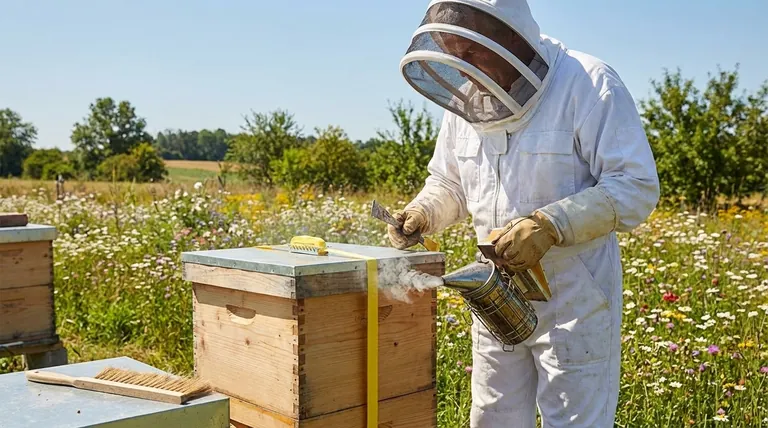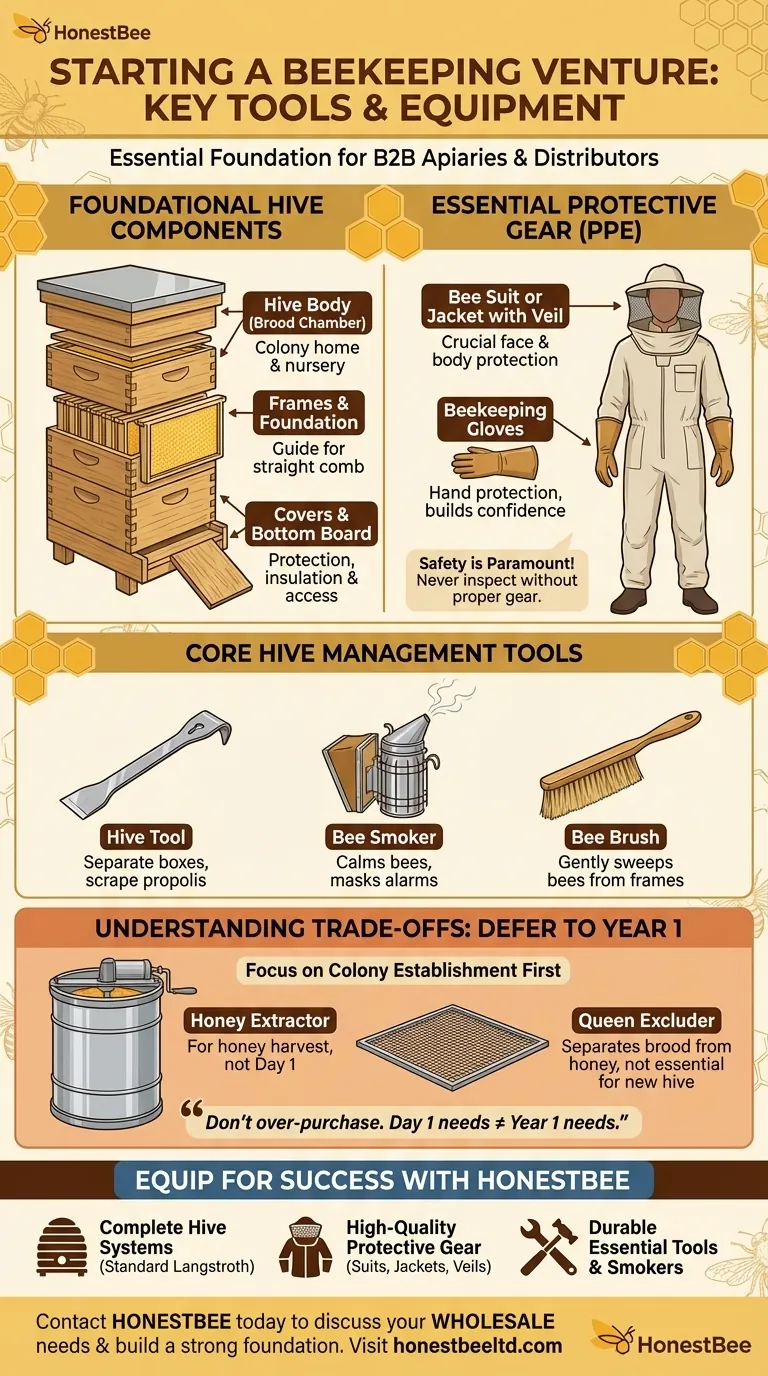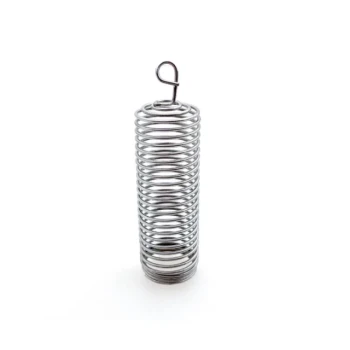To begin beekeeping, you need four core items: a complete beehive to house the colony, protective clothing like a suit or jacket with a veil, a hive tool for manipulating components, and a smoker to calm the bees. These items form the non-negotiable foundation for safely managing your first colony.
The most common mistake for new beekeepers is over-purchasing equipment for tasks they won't perform for a year or more. The key is to separate your "Day 1" needs for hive management from your "Year 1" needs for honey harvesting.
Foundational Hive Components
The hive is the bee's home and your primary point of interaction. Choosing a standard style, like the Langstroth hive, ensures you can easily find replacement parts and educational resources.
The Hive Body: Boxes, Frames, and Foundation
A basic hive consists of stacked boxes. The larger, lower boxes form the brood chamber, where the queen lays eggs and the colony raises new bees.
Inside each box hang removable frames. Beekeepers install a sheet of foundation—typically beeswax imprinted with a honeycomb pattern—into each frame to give the bees a guide for building straight, manageable combs.
The Bottom Board, Inner Cover, and Outer Cover
The bottom board serves as the floor of the hive and provides an entrance for the bees. An inner cover provides a layer of insulation and space, while the telescoping outer cover acts as the roof, protecting the hive from weather.
Essential Personal Protective Equipment (PPE)
Your safety is paramount. Never inspect a hive without proper protective gear, as even a gentle colony can become defensive.
The Bee Suit or Jacket
A full bee suit offers maximum protection and is highly recommended for beginners who may be more nervous. A beekeeping jacket with an attached veil is a popular alternative, offering excellent upper-body protection while being less cumbersome and more affordable.
The Veil and Gloves
The veil is the most critical piece of PPE, protecting your face and neck. It is non-negotiable. Beekeeping gloves, typically made of leather, protect your hands and build confidence when handling frames covered in bees.
Core Hive Management Tools
These are the hand tools you will use during every single hive inspection. Their simplicity belies their importance.
The Hive Tool
This is the beekeeper's multi-tool. It's a small, hardened pry bar used to separate hive boxes and frames, which bees glue together with a substance called propolis. You will also use it to scrape away excess wax and propolis.
The Smoker
A bee smoker is a small canister with bellows used to burn fuel (like pine needles or burlap) to produce cool, white smoke. Puffs of smoke mask the bees' alarm pheromones, calming the colony and reducing defensive behavior during inspections.
The Bee Brush
A bee brush has very soft bristles and is used to gently sweep bees off a frame. This is useful when you need a clear view or when you are moving frames during a harvest.
Understanding the Trade-offs: What to Buy Later
Many beekeeping supply lists include equipment that is unnecessary for a first-year beekeeper. Understanding what you can defer purchasing will save you money and storage space.
Honey Harvesting Equipment (Year 1, Not Day 1)
Your primary goal in the first year is to help the colony grow strong and survive the winter. It is unlikely you will have a significant honey surplus to harvest.
Equipment like honey extractors, uncapping tools, and filters are significant investments that can wait until your second season, once you have confirmed your hive is productive.
The Queen Excluder
A queen excluder is a screen that allows worker bees to pass through but is too small for the larger queen. It is used to keep the queen from laying eggs in the honey supers (the boxes for honey storage). This is a useful tool for honey production but is not essential for a brand-new hive.
Making the Right Choice for Your Venture
Your initial equipment choices should align with your budget and your primary goal for the first year: establishing a healthy, thriving colony.
- If your primary focus is starting on a minimal budget: Concentrate on a single hive, a jacket/veil combination, gloves, a hive tool, and a smoker.
- If your primary focus is prioritizing safety and comfort: Invest in a high-quality, full ventilated bee suit for maximum protection and airflow on hot days.
- If your primary focus is planning for the entire first year: In addition to the basics, consider purchasing a feeder to help the new colony get established, and start researching honey extraction equipment for your second year.
Ultimately, arming yourself with the correct foundational tools empowers you to manage your bees confidently and effectively from the very first day.

Summary Table:
| Category | Essential Equipment | Purpose |
|---|---|---|
| Hive System | Hive Bodies, Frames, Foundation, Covers | Provides a home for the colony and allows for management. |
| Protective Gear | Bee Suit/Jacket, Veil, Gloves | Protects the beekeeper during hive inspections. |
| Core Tools | Hive Tool, Smoker, Bee Brush | Essential for safely opening, inspecting, and manipulating the hive. |
| Defer Purchasing | Honey Extractor, Queen Excluder | Unnecessary for the first year; focus on colony establishment. |
Ready to Equip Your Beekeeping Venture with Confidence?
Starting with the right foundation is key to a successful and safe beekeeping experience. At HONESTBEE, we specialize in supplying durable, reliable beekeeping supplies and equipment tailored for commercial apiaries and beekeeping equipment distributors.
We provide the essential tools you need to thrive:
- Complete Hive Systems: Standard Langstroth components for easy management.
- High-Quality Protective Gear: From jackets to full ventilated suits for maximum safety.
- Essential Tools & Smokers: Built to last through countless hive inspections.
Let us help you build a strong foundation for your operation. Contact HONESTBEE today to discuss your wholesale needs and get started on the right foot.
Visual Guide

Related Products
- Professional Galvanized Hive Strap with Secure Locking Buckle for Beekeeping
- Heavy-Duty Nylon Beehive Hive Strap with Stainless Steel Cinch Buckle
- Versatile Ratchet Hive Strap with S-Hooks for Secure Fastening
- Heavy Duty Ratchet Hive Strap
- Professional Reversible Beehive Hive Entrance
People Also Ask
- How can beekeepers secure the top cover of a hive? Protect Your Colony from Wind and Weather
- What is the best length for straps used around beehives? Why 12 Feet is the Industry Standard
- What is the advantage of using cam buckle straps? Secure Your Load Fast with Simple, Safe Tensioning
- What are hive straps and why are they used? Secure Your Hives Against Wind, Predators, and Transport
- Can straps with hook ends be used for beehives? A Guide to Secure Hive Management



















